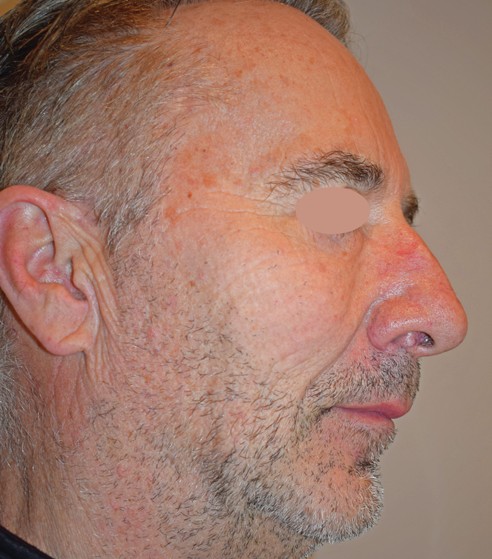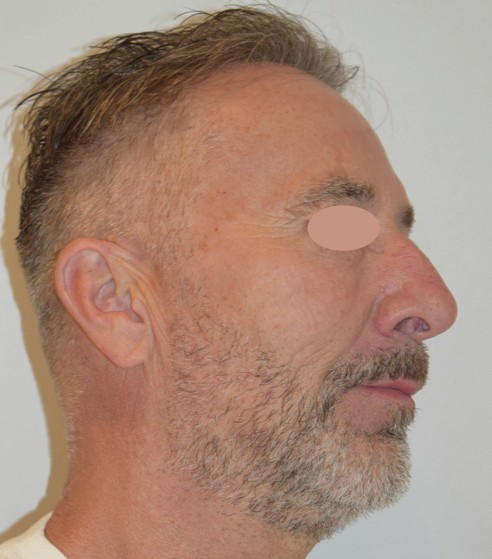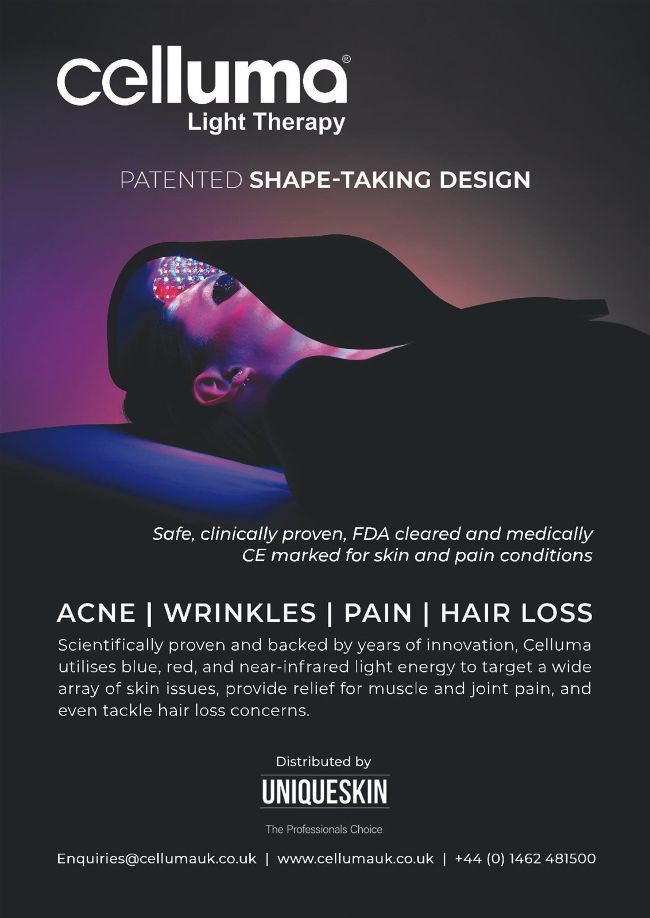PHOTODAMAGE AND SOLAR ELASTOSIS
A MULTI-MODAL APPROACH TO CORRECTING PHOTODAMAGE
Independent nurse prescriber Yuliya Culley discusses how she treated a male patient, who presented with chronic photodamage and solar elastosis, using a multi-disciplinary approach
YULIYA CULLEY
Yuliya Culley is a registered general nurse and independent prescriber, who qualified in 1998 and has general experience in emergency, cardiology and dermatology nursing. She is a member of the Royal College of Nursing (RCN), The British Association of Cosmetic Nurses (BACN) and the Association of Nurse Prescribing (NP). She is clinical director of Novello Skin, Cheltenham, Gloucestershire.
Advances in medical aesthetics innovations mean combined, regenerative treatments are increasingly popular. However, many patients who are new to aesthetics, particularly men, want to look revitalised, but still feel comfortable in their own skin, with no obvious changes to their appearance.
With these factors in mind, my treatment choice for this patient was a combination of energy-based devices, polynucleotides, and clinical-grade skincare to initiate significant improvements to the patient’s skin quality and appearance.
CASE STUDY
This 69-year-old, Caucasian male patient with skin type 3 has attended the clinic for several years for procedures including muscle-relaxing injections to his upper face, after an original referral by his wife. More recently he was concerned about the quality of his skin, which was asymmetrical as a result of chronic photodamage, causing advanced solar elastosis to his right cheek. He believed the damage was caused by long hours spent outside, driving and sun exposure without sun protection over the years. His work requires him to socialise regularly with important clients at major events, so he wanted a fresher look without his face really appearing to have changed.
TREATMENT PLAN
During his initial consultation, we discussed various options, including medium grade chemical peels, injectable Profhilo filler and plasma treatments. The prospect of his skin peeling a lot and the extended downtime of a peel ruled out this option. He was also reluctant to have Profhilo because of its limited longevity meaning the treatment would need to be repeated every six months. Equally, we ruled out plasma treatment because of the downtime after each session.
As a result, I developed a regenerative treatment plan with limited downtime which would have the longevity he required and tackle the solar elastosis to his right cheek.
For the initial stage of treatment, I prescribed ZO Skin Health clinical grade skincare for cleansing and toning, ZO Daily Power Defence and ZO Skin Health Retinol Skin Brightener with 0.5% retinol for pigmentation, collagen stimulation and skin renewal, plus an SPF 50 sunscreen.
This was followed by:
• Medical microneedling with radiofrequency (RF) course of three sessions, four to six weeks apart
• Three sessions of polynucleotides using 40mg/2ml syringe for each session, three weeks apart, followed by session of LED red and near infrared light
• CO2 laser resurfacing four weeks after the course of polynucleotides.
This sequence of treatments was chosen to ensure gradual results and to condition the skin prior to the final resurfacing procedure. Downtime was also an important consideration because I knew that getting my patient to return to the clinic for follow-up sessions could be challenging because he was concerned about discomfort and bruising. Microneedling with RF is well known for its short downtime and recovery process.1
Microneedling with RF: For this treatment I started with Cutera’s Secret RF before upgrading to Secret Pro when it became available. The skin was prepared with Clinisept. I then established an accurate endpoint, with mild-to-moderate erythema and oedema, via a test shot to each area.5 For the treatment itself, I used a 25-pin, semi-insulated tip, making two to three passes to various depths - from deeper to more superficial sequences to ensure uniform skin coverage, and more advanced results.2,3 This treatment tackled sun damage and improved collagen synthesis simultaneously.1,3
Aftercare included ZO Hydrating Cleanser, post-laser recovery sheet masks, Biafine cream and SPF 50 mineral block.
Polynucleotides injections: I added in this treatment prior to the CO2 fractional laser because polynucleotides have antiinflammatory and wound healing properties, DNA repairing activity and collagen synthesis – helping to increase skin regenerative properties.4,5 This treatment can result in visible micro-papules post procedure and bruising, meaning a downtime of two to three days.5 However, because the patient was already seeing some positive results post microneedling RF, he felt the downtime was manageable.
To further help collagen synthesis, the patient received Dermalux phototherapeutic LED red and near infrared light in 10-minute sessions after each procedure,6 plus sheet masks for posttreatment homecare.
CO2 fractional laser for advanced skin resurfacing: I prepared the patient’s skin using a topical anaesthetic of 4% Lidocaine (LMX4) 30 min prior to his procedure, followed by Clinisept.2 He wore laser goggles to protect his eyes and I administered a patch test 10 days prior to the main treatment session.7
The treatment itself comprised an energy setting of 61mJ and laser density setting of 1.5mm, with double passes around the sun damaged areas, including his glabella, anterior and lateral cheeks. The settings were selected within the manufacturer’s settings guide for deep skin resurfacing for the face.8
To minimise swelling and erythema post-procedure, I used cold compresses immediately following treatment. A smoke evacuator isolated any fumes generated by the treatment.7 The patient was sent home with an aftercare pack tailored to his needs containing a post laser sheet mask, Clinisept spray, Biafine emulsion and mineral SPF 50 sun block. He was also advised to contact clinic on any sign of infection or impaired wound healing.
At the end of treatment, I conducted routine reviews one, four and eight weeks post-procedure to evaluate healing, results, and my patient’s level of satisfaction.

Before

After
THE RESULTS
The combined treatments have produced a noticeable difference to the patient’s skin; it is now smoother, with a marked reduction in discrepancies between the appearance in depth of the lines and wrinkles on the right compared to the left side of his face.
He is happy with the results, which should last up to two years, and has more confidence in his appearance, feeling more selfassured both in work scenarios and when with friends and family.
Importantly, he is continuing with his tailored, clinical grade skincare regime and I have advised him to see me annually to maintain the improved skin condition.
REFERENCES
1. Ramault, L., Heoksema, H. and Pirayesh (2018) Microneedling: Where do we stand now? Asystematic review of the literature. Journal of Reconstructive Aesthetic Surgery. 71 (1). Doi: 10.1016/j.bjps.2017.06.006.
2. Jesitus, J. (2018) Cutera Secret RF Dials Up Flexibility. The Aesthetic Guide. March/ April 2018. Available at: aestheticchannel.com
3. Sarti, M. (2018) Clinical results using Secret RF fractional microneedling system for skin rejuvenation. Clinical Bulletin, Cutera Inc.AP 1830, Rev A (04/18).
4. Cavallini, M., De Luka, C. and Prussia, G. (2021) PN-HPT ( Polynucleotides Highly Purified Technology) in facial middle third rejuvenation. Exploring the potential. Journal of Cosmetic Dermatology. 00:1-10. DOI: 10.1111/jocd.14578.
5. Cavallini, M., Bartoletti, E., Maioli, L, et al (2020) Consensus report on the use of PNHPT (polynucleotides highly purified technology) in aesthetic medicine. Journal of Cosmetic Dermatology. 00:1-10. DOI:10.1111/jocd.13679.
6. Yadav, A., and Gupta. A. (2016) Noninvasive red and near-infrared wavelengthinduced photobiomodulation: promoting impaired cutaneous wound healing. Photodermatology, Photoimmunology and Photomedicine. 33 (1): 4-13.
7. Lapa, Tand Mandavia, R. (2021) Treating multiple skin concerns with less down-time. PMFA Journal. 9(2). Available at: thepmfajournal.com/education/how-i-do-it/post/how-i-do-it-treating-multiple-skin-concerns-with-less-down-time
8. Cutera (2022) Secret PRO, Treatment Guidelines. Cutera. 02660
9. Tan M., Jo C, Chapas A, Khetarpal S., and Dover J. (2021) Radiofrequency Microneedling: AComprehensive and Critical Review. Dermatol Surg.1;47(6):755-761. doi: 10.1097/DSS.0000000000002972.
